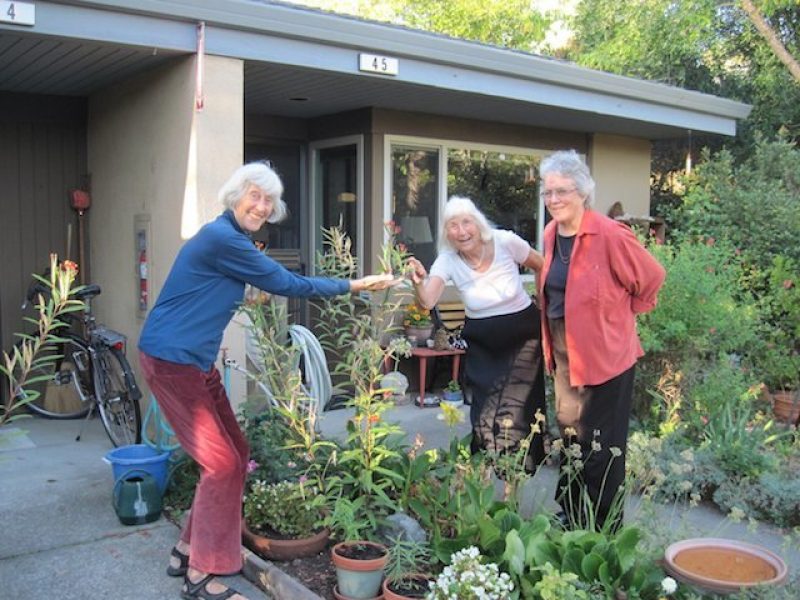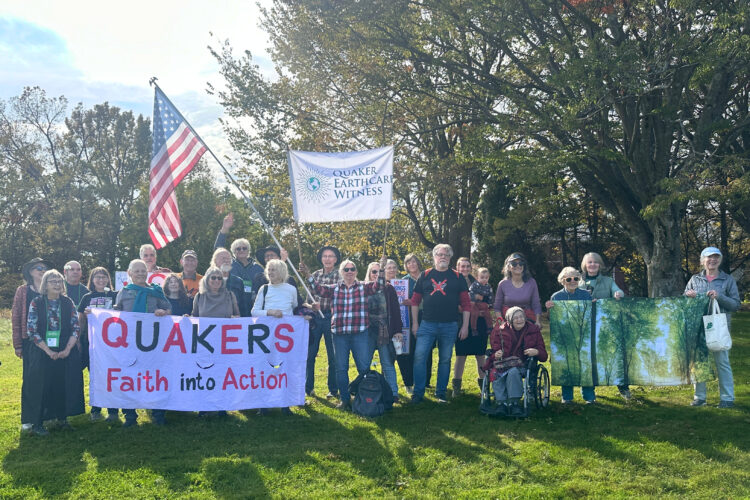Ecological Living at Quaker Retirement Community

By Elizabeth Boardman.
PERHAPS, IF WE HAD ASKED THEM, our grandchildren could have told us before we came here to Friends House what benefits we would accrue by moving out of the big family home to a small apartment. And now we could tell them the advantages of a communal apartment complex where people deliberately share and “go green” in terms of water, energy, and resources of all kinds.
Friends House is a Quaker retirement community in Santa Rosa, California. Many of the 80 or so people living in apartments here came from single-family homes. The adjustment to a smaller personal living space was always a temporary challenge.
But in these days of concern about climate change, an important pay-off is immediately visible. The life style at Friends House is far more ecologically sustainable than the way we were living before, especially for those of us (about 80%) who are single.
Who really needs more than a living room, a kitchen alcove, a bedroom, and a bath, when there is plenty of community space to share? Our garden tools are in the communal tool shed, our extra books are in the Friends House library (about 5,000 books total). We each share laundry facilities (one washer, one dryer, one clothes line, and an ironing board and iron) with about 12-15 others, and there is virtually never a waiting line. (No quarters required, either!) Cece comes with the vacuum cleaner once in two weeks and Antonio mows the lawns, so we don’t have to own or store those machines. In many places, grass that needs watering and mowing has been replaced with drought-tolerant native plants.
Only about half of Friends House residents own cars, and about a third of the cars are hybrids or electric. We have a rule for pedestrians about facing towards on-coming traffic when we walk “the Ring Road” around the campus, so that we will see the inaudible electric vehicles coming near us. Those with cars share the cars or rides, and the whole community owns a van and hires a driver to transport many at one time, so that our carbon footprint is modest. For trips away, many of us take trains, not planes.
We old ladies and gentlemen are wary of using too much gas and electricity. Many of us capture first-flow cold water to use on potted plants and in the johns. The basic design of the place is geared to maximization of sun and shade according to the season. Many of our roofs have solar tubes and solar panels, and more are expected soon.
Every “cottage” apartment is on the ground floor with its own little garden. The lawns and patios are shared by groupings of 15-20 apartments. The vegetable gardens “out back” belong to the whole community. And the harvest from the 50 fruit trees is shared and used to the max, “drops” and all, with jars of jellies and jams lasting long into the cold season or sold at the annual Holiday Faire to raise funds for the Resident Support Fund. Most of the money for that fund comes from “Susan’s Table,” right up in the front lobby, where residents, staff, and well-wishers alike recycle clothes and small objects. Books, on the other hand, get donated to our big library. If they are not shelved there, they get sold online by an enterprising resident committee, again for the benefit of the Support Fund.
Instead of a large formal dining room with assigned seating, we have a modest communal café where all who come (including guests and staff members) are welcome to sit anywhere as they arrive, and choose from a limited choice of healthy foods, always with vegetarian choices.
We are pleased to be living so light on the land. Perhaps this is the sustainable way that everyone should be living these days—except perhaps families with growing children. Indeed, more and more younger adults live, like us, in shared housing or small apartments, using Uber or public transportation instead of private cars, eating at restaurants and from modest take-out vendors instead of maintaining a big kitchen. This life style is based on respect for Mother Nature and for one another.

